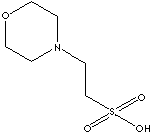PRODUCT IDENTIFICATION
71119-23-8 (hydrochloride)

CLASSIFICATION
PHYSICAL AND CHEMICAL PROPERTIES
REFRACTIVE INDEX
EXTERNAL LINKS & GENERAL DESCRIPTION
Drug Information Portal (U.S. National Library of Medicine) - MES
PubChem Compound Summary - MES
http://www.ebi.ac.uk/chebi/ - MES
http://www.ncbi.nlm.nih.gov/ - MES
Local: Buffer is a substance, generally a solution, that can keep its pH constant, despite the addition of strong acids or strong bases and external influences of temperature, pressure, volume, redox potential. Buffer prevents change in the concentration of another chemical substance, e.g., proton donor and acceptor systems that prevent marked changes in hydrogen ion concentration (pH). Many acid-base reactions take place in living organisms. However, for organisms to perform certain vital functions, the body fluids associated with these functions must maintain a constant pH. For example, blood must maintain a pH of close to 7.4 in order to carry oxygen from the lungs to cells; blood is therefore a powerful buffer. The commonest buffer in chemical solution systems is the acid-base buffer.
- Bicarbonate buffer; a buffer system composed of bicarbonate ions and dissolved carbon dioxide; in the body, this system is an important factor in determining the pH of the blood as the concentration of bicarbonate ions is regulated by the kidneys and of carbon dioxide by the respiratory system.
- Cacodylate buffer; one containing an organic arsenical salt, used in preparing fixatives for electron microscopy.
- Phosphate buffer, a buffer system composed of KH2PO4 and Na2HPO4; in the body, it is important in regulating the pH of the renal tubular fluids; when 0.025 molal (equimolal of the potassium and sodium salts), the pH is 6.865 at 25 C.
- Protein buffer, a buffer system involving proton donor and proton acceptor groups of the amino acid residues of proteins.
- TRIS buffer (tromethamine): an amine base used intravenously as an alkalizer for the correction of metabolic acidosis. The pH values of all buffers are temperature- and concentration-dependent. For Tris buffers, pH increases about 0.03 unit per C temperature decrease, and decreases 0.03-0.05 unit per ten-fold dilution.
- Veronal buffer; a barbital buffer commonly used in the preparation of fixatives for electron microscopy.
|
|
APPEARANCE
99.0% min
LOSS ON DRYING
3.0% max
Cl
100ppm max
SO4
500ppm max
HEAVY METALS
pH
PRICE INFORMATION